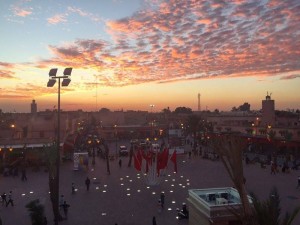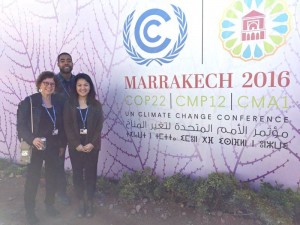Day 2 in Marrakech and day 1 (of week 2) of the 22nd Conference of Parties complete for the second Swarthmore Delegation. Things have been going smoothly thus far and our experience has been a satisfying mix of ad hoc and deliberate scheduling to get the most out of both the busy Conference and the inviting sites in the city. Already in our last 32 hours here, since arriving on Sunday afternoon (Marrakech time), we have managed to explore the labyrinth of outdoor vendors in the Souk and twice dined on delicious dinners ranging from pastille platters and tangine dishes on rooftop restaurants within the Medina (the old city within Marrakech). Thanks to the advice from the first Swarthmore delegation as well as the kind Moroccan city dwellers, we have gotten familiar with transit costs, navigating the COP space, and of course, learning the tricks to optimize the hotel wi-fi.

We’ll be sure to share plenty of details of specific workshops and negotiations as the week progresses, but first, a brief overview of the COP itself may be helpful for understanding the importance of this meeting, and for demonstrating that we are here for more than just delicious mint tea, beautiful weather, and a head start on Christmas shopping.
The COP is the actual international meeting that has been held annually since 1995, to actualize the United Nations Framework Convention on Climate Change (UNFCCC). UNFCCC was first established in Rio de Janeiro in 1992, where the international community decided to begin negotiations in which nations would voluntary work to reduce carbon emissions. The Kyoto Protocol established in 1997 was one of the first COPs that yielded somewhat substantive results for nations to commit to cut carbon emissions, yet lack of participation from large emitters (including the U.S.) combined with weak targets resulted in little global progress towards carbon emission reductions. The Kyoto Protocol differentiated between Annex I (developed) and non-Annex I (less developed) nations, with developed nations bearing responsibilities for reducing CO2 emissions. (Harris et. al., 2015, 9) Since China and India were among the non-Annex I nations and had no formal responsibility to curb carbon emissions, the U.S. Congress would not ratify Kyoto. Carbon emissions trading under Kyoto failed to be effective to bring down CO2 levels.
By many measures, the next substantive meeting that showed any hopeful progress was 18 years later in COP 21 in Paris. With China and the U.S., the world’s two greatest carbon emitters, finally cooperating in the 2015 conference broadly considered “the last chance”, the world finally made three especially important strides towards carbon emissions reductions. The Paris Agreement ended the formal, differentiated responsibility of Annex I and non-Annex I nations, it provided flexibility of states’ contributions in a way that encourages participation, and it establishes 5 year reviews of states’ progress. (Kaya, Desai, 2016, 5, 6) The Paris Agreement also bolstered recognition of the need to pursue more ambitious emissions reductions, marking a global temperature increase of 1.5ºC increase from pre-industrial levels as the goal, rather than the previous goal of no more than a 2.0ºC increase (Obergassel et. al. 2016, 14, 15) The Paris Agreement was officially ratified on November 4, 2016- way sooner than most expected- after a enough countries (the required 55% threshold) signed on to the agreement in October of this year. (Reuters, 2016)

While the progress made in COP 21 rejuvenated hope in the ability of productive international diplomacy on climate change, challenges remain. Calculations of the world’s current emissions reduction plans still project that the global temperature increase will range from 2.7ºC to 3.5ºC, far exceeding the 1.5 to stay alive as was chanted by many small island nation representatives at the Paris conference. Additionally, the Paris Agreement is not legally binding, but only provides a system of “naming and shaming” through its 5 year reviews in which nations share progress. (Obergassel et. al., 3) And, of course the election of a president and a congressional majority that tends to disregard the scientific projections from the international science community, in addition to its own EPA, DOD, and CBO, is not helpful.
The rest of the global community however is continuing to work towards its moral and technical responsibilities to address the global climate crisis. We’ll keep you updated on how these efforts are playing out.
Need to properly format still (after finals), but references for now:
Harris, Jonathan M. Roach, Brian. Codur, Anne-Marie. The Economics of Global Climate Change, Global Development and Environment Institute, Tufts University. Medford Ma. 2015
Kaya, Ayse. Desai, Anita. COP 21 and the Paris Agreement: Change and Status Quo. Global Policy, August 2016
Obergassel, Wolfgang. Arens, Christof. Hermwille, Lukas. Kreibich, Nico. Mersmann, Florian. Ott, Hermann E., Wang-Helmreich, Hanna. Phoenix from the Ashes- an Analysis of the Paris Agreement to the United Nations Framework Convention on Climate Change, Wuppertal Institute for Climate Environment and Energy, 01 March 2016
Reuters Paris climate accord to take effect; Obama hails ‘historic day’ http://www.reuters.com/article/us-climatechange-paris-idUSKCN12523G, Published October 5, 2016. Accessed October 2016